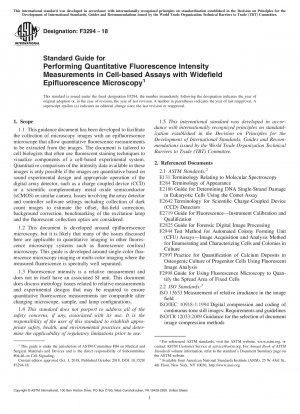ASTM F3294-18
Standard Guide for Performing Quantitative Fluorescence Intensity Measurements in Cell-based Assays with Widefield Epifluorescence Microscopy
- Standard No.
- ASTM F3294-18
- Release Date
- 2018
- Published By
- American Society for Testing and Materials (ASTM)
- Latest
- ASTM F3294-18
- Scope
- 1.1 This guidance document has been developed to facilitate the collection of microscopy images with an epifluorescence microscope that allow quantitative fluorescence measurements to be extracted from the images. The document is tailored to cell biologists that often use fluorescent staining techniques to visualize components of a cell-based experimental system. Quantitative comparison of the intensity data available in these images is only possible if the images are quantitative based on sound experimental design and appropriate operation of the digital array detector, such as a charge coupled device (CCD) or a scientific complementary metal oxide semiconductor (sCMOS) or similar camera. Issues involving the array detector and controller software settings including collection of dark count images to estimate the offset, flat-field correction, background correction, benchmarking of the excitation lamp and the fluorescent collection optics are considered. 1.2 This document is developed around epifluorescence microscopy, but it is likely that many of the issues discussed here are applicable to quantitative imaging in other fluorescence microscopy systems such as fluorescence confocal microscopy. This guide is developed around single-color fluorescence microscopy imaging or multi-color imaging where the measured fluorescence is spectrally well separated. 1.3 Fluorescence intensity is a relative measurement and does not in itself have an associated SI unit. This document does discuss metrology issues related to relative measurements and experimental designs that may be required to ensure quantitative fluorescence measurements are comparable after changing microscope, sample, and lamp configurations. 1.4 This standard does not purport to address all of the safety concerns, if any, associated with its use. It is the responsibility of the user of this standard to establish appropriate safety, health, and environmental practices and determine the applicability of regulatory limitations prior to use. 1.5 This international standard was developed in accordance with internationally recognized principles on standardization established in the Decision on Principles for the Development of International Standards, Guides and Recommendations issued by the World Trade Organization Technical Barriers to Trade (TBT) Committee.
ASTM F3294-18 Referenced Document
- ASTM E131 Standard Definitions of Terms and Symbols Relating to Molecular Spectroscopy
- ASTM E2186 Standard Guide for Determining DNA Single-Strand Damage in Eukaryotic Cells Using the Comet Assay*, 2023-12-01 Update
- ASTM E2642 Standard Terminology for Scientific Charge-Coupled Device (CCD) Detectors*, 2021-09-01 Update
- ASTM E2719 Standard Guide for Fluorescence—Instrument Calibration and Qualification*, 2022-11-01 Update
- ASTM E2825 Standard Guide for Forensic Digital Image Processing*, 2021-10-01 Update
- ASTM E284 Standard Terminology of Appearance
- ASTM F2944 Standard Practice for Automated Colony Forming Unit (CFU) Assays—Image Acquisition and Analysis Method for Enumerating and Characterizing Cells and Colonies in Culture*, 2020-04-01 Update
- ASTM F2997 Standard Practice for Quantification of Calcium Deposits in Osteogenic Culture of Progenitor Cells Using Fluorescent Image Analysis*, 2024-04-21 Update
- ASTM F2998 Guide for Using Fluorescence Microscopy to Quantify the Spread Area of Fixed Cells*, 2024-04-21 Update
- ISO 13653 Optics and photonics — General optical test methods — Measurement of relative irradiance in the image field*, 2019-05-14 Update
ASTM F3294-18 history
- 2018 ASTM F3294-18 Standard Guide for Performing Quantitative Fluorescence Intensity Measurements in Cell-based Assays with Widefield Epifluorescence Microscopy
